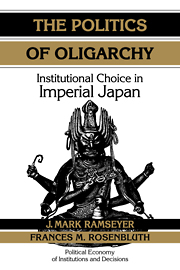Book contents
- Frontmatter
- Contents
- List of tables and figure
- Series editors' preface
- Acknowledgments
- CHAPTER 1 INTRODUCTION
- CHAPTER 2 THE COLLAPSE OF OLIGARCHY: FAILED ATTEMPTS AT CARTEL-MAINTENANCE
- CHAPTER 3 CONCESSION OR FACADE: THE MEIJI CONSTITUTION
- CHAPTER 4 ELECTORAL RULES AND PARTY COMPETITION: THE STRUGGLE FOR POLITICAL SURVIVAL
- CHAPTER 5 THE BUREAUCRACY: WHO RULED WHOM?
- CHAPTER 6 THE COURTS: WHO MONITORED WHOM?
- CHAPTER 7 THE MILITARY: MASTER OF ITS OWN FATE
- CHAPTER 8 FINANCIAL POLITICS
- CHAPTER 9 RAILROAD POLITICS
- CHAPTER 10 COTTON POLITICS
- CHAPTER 11 CONCLUSION: INSTITUTIONS AND POLITICAL CONTROL
- Notes
- References
- Index
CHAPTER 7 - THE MILITARY: MASTER OF ITS OWN FATE
Published online by Cambridge University Press: 05 June 2012
- Frontmatter
- Contents
- List of tables and figure
- Series editors' preface
- Acknowledgments
- CHAPTER 1 INTRODUCTION
- CHAPTER 2 THE COLLAPSE OF OLIGARCHY: FAILED ATTEMPTS AT CARTEL-MAINTENANCE
- CHAPTER 3 CONCESSION OR FACADE: THE MEIJI CONSTITUTION
- CHAPTER 4 ELECTORAL RULES AND PARTY COMPETITION: THE STRUGGLE FOR POLITICAL SURVIVAL
- CHAPTER 5 THE BUREAUCRACY: WHO RULED WHOM?
- CHAPTER 6 THE COURTS: WHO MONITORED WHOM?
- CHAPTER 7 THE MILITARY: MASTER OF ITS OWN FATE
- CHAPTER 8 FINANCIAL POLITICS
- CHAPTER 9 RAILROAD POLITICS
- CHAPTER 10 COTTON POLITICS
- CHAPTER 11 CONCLUSION: INSTITUTIONS AND POLITICAL CONTROL
- Notes
- References
- Index
Summary
INTRODUCTION
For their civil bureaucracy and courts, the Imperial Japanese oligarchs built an institutional framework that let cabinet ministers monitor and control the men they hired (Chapters 5 and 6). Bureaucrats and judges thus answered to the cabinet. During the first Meiji decades, the oligarchs jockeyed to control that cabinet. During the 1920s, the professional politicians did the same.
For their military, the oligarchs built a radically different framework. They – but primarily Yamagata Aritomo – instead built an institutional framework that gave power to those (1) who retained access to the Emperor, and (2) who cultivated particularistic ties of loyalty within the military. Consider the detail. First, the Emperor maintained formal control over the military. As a result, to shape basic military contours, one needed to be able to manipulate the Emperor. This favored Yamagata and most of his fellow oligarchs over the politicians; it did not favor Yamagata over many of his oligarchic competitors.
Second, military leaders could bypass the cabinet in drafting regulations, in making operational command decisions, and in picking their ministers. Effectively this meant that a place in the cabinet did not give a man control over the military. Instead, to control it he needed personal ties within it. This favored Yamagata over most of his fellow oligarchs, for Yamagata had purged his opponents from the Army and stacked it with loyal men. As long as he lived, the Army was independent in theory, but not in fact.
- Type
- Chapter
- Information
- The Politics of OligarchyInstitutional Choice in Imperial Japan, pp. 90 - 102Publisher: Cambridge University PressPrint publication year: 1995



